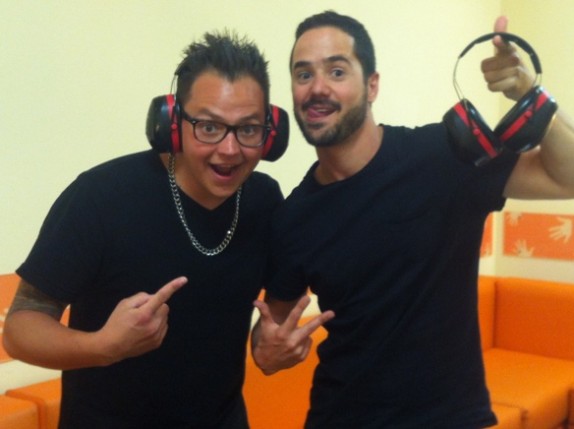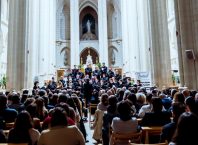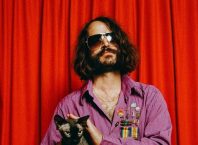Between us, we spoke a multitude of languages. Sean Forbes, the deaf rapper, visiting from the United States, communicates both with American Sign Language and verbally, in English; his companion just with the former. I speak English and a undocumented bastardisation of Hebrew; Talya, our guide for the afternoon at the Children’s Museum in Holon, uses Hebrew Sign Language. But it doesn’t take long to break the barriers down.

The exhibit, Invitation to Silence, is curated primarily – but not exclusively – with children in mind, and is about the potential for silence in our everyday lives. After we don noise-cancelling headphones, Talya leads us through a series of exercises. Using rudimentary signs and signals alone – remember, only she communicates in Hebrew Sign Language – she coaxes, cajoles and teases us into working individually and as a team into translating her intentions into statements. A beating heart, a star in the sky; the exercise is very much about discovering the hidden potential we have to make ourselves understood without speaking. This is a fascinating revelation for me, unsurprisingly. But it is both charming and surprising to see Forbes, deaf since childhood, equally entranced and engaged.
We go through to another room. Standing in a circle, we place our heads in squares that resemble portrait frames. Talya explains, again through rudimentary signage, what is going to happen. A revolving platform on the floor reveals a sequence of facial expressions. Can we recognise them for what they are and replicate them? It’s both fun and revealing; laughing and cackling (not that I can actually hear them, of course) with two absolute strangers is uncharted territory for me. Finding out that I can communicate joy and pain and puzzlement and hunger (the last was a cinch, admittedly) something of a surprise.
But so too Forbes. It’s clear that he is impressed by the exhibit. What does it tell him about the experience of being deaf in Israel? “I think there’s more accessibility in the States,” he ventures. “But I think there is more cultural acceptance here, in Israel.” Invitation to Silence is aimed at children aged 9 and over – an impressively young demographic. As Forbes points out, perhaps the principal obstacle faced by the deaf community is the lack of awareness of the challenges they face by mainstream society. “There’s a lack of sensitivity to the needs of the deaf community,” he says. Which the exhibit strives to challenge, by catching the mainstream young.
Forbes, 32, was born in Detroit Michigan. He became deaf at 5 months, following a bout of spinal meningitis. He grew up in a hearing family, one deeply invested in music and performance; his father was part of a country-rock outfit, his mother a pianist. He grew up around music, “Beatles, Rolling Stone, Motown…” he recalls. He discovered in himself an early affinity for the drums, drawn to the patterns and rhythms; his brothers, heavy metal fans, broadened his repertoire to include bass and “heavy guitar sounds.”
Rap came in the late 90s: “it’s principally vocalised lyrics in a drum pattern,” Forbes enthuses. Growing up, his family had lip-synced songs to him; “Rap was easier to follow, clearer,” he explains. It’s no coincidence, I’d wager, either that Rap draws as much upon the physicality often inherent in its delivery, theatre as much for the eyes as it is for the ears. Forbes’ style, signing and rapping, is as much a visual as an aural treat. (A selection of his videos are available on his website, www.deafandloud.com)
Music is both the passion and the vehicle, for promoting awareness of deaf issues in the mainstream. In conjunction with – it is more accurate to say, I think, as a part of – his music career, Forbes is also the co-founder of D-PAN, the Deaf Professional Arts Network. D-PAN works with musicians and performers to make their music more accessible to deaf audiences. Amongst other initiatives, D-Pan have created American Sign Language interpretations of hits by major American recording artists.
The visit to the Children’s Museum was towards the tail-end of a two week tour of Israel, taking in performances in Tel Aviv, Jerusalem and Nazareth, and trips to heritage sites like Masada and the Dead Sea. “It’s been an eye-opening experience for me,” Forbes says. “I’m used to audiences who know American Sign Language.” It’s humbling, he continues, that despite the language barrier, his work is recognised and appreciated in Israel. But it isn’t about him. The common experience of deafness, he discovered, was both surprising and satisfying; so too the chance to see that music can make a difference to lots of people, hearing and non-hearing. This serves as a spur. “If I, as a deaf person can do this, it shows that deaf people can do anything”
Invitation To Silence, created by Orna Cohen and Dr. Andreas Heinecke is on-going at the Children’s Museum, Holon.
As a part of its Shavuot Fair 2014 and the National Hearing Day, on Wednesday 4th June 2014 there will be a range of activities linked to the Invitation to Silence exhibit. These will include a Sign Language Workshop, where children will have the opportunity to familiarise themselves with basic words in Hebrew Sign Language, and to learn a special song for Shavuot. The outdoor event is open to the public free of charge, there is a fee of 25 NIS for participation in the workshops which will take place at 10:00, 11:15, 12:30, and 14:00 and are intended for ages 4 – 8. To reserve a place, call 03-6503000.





